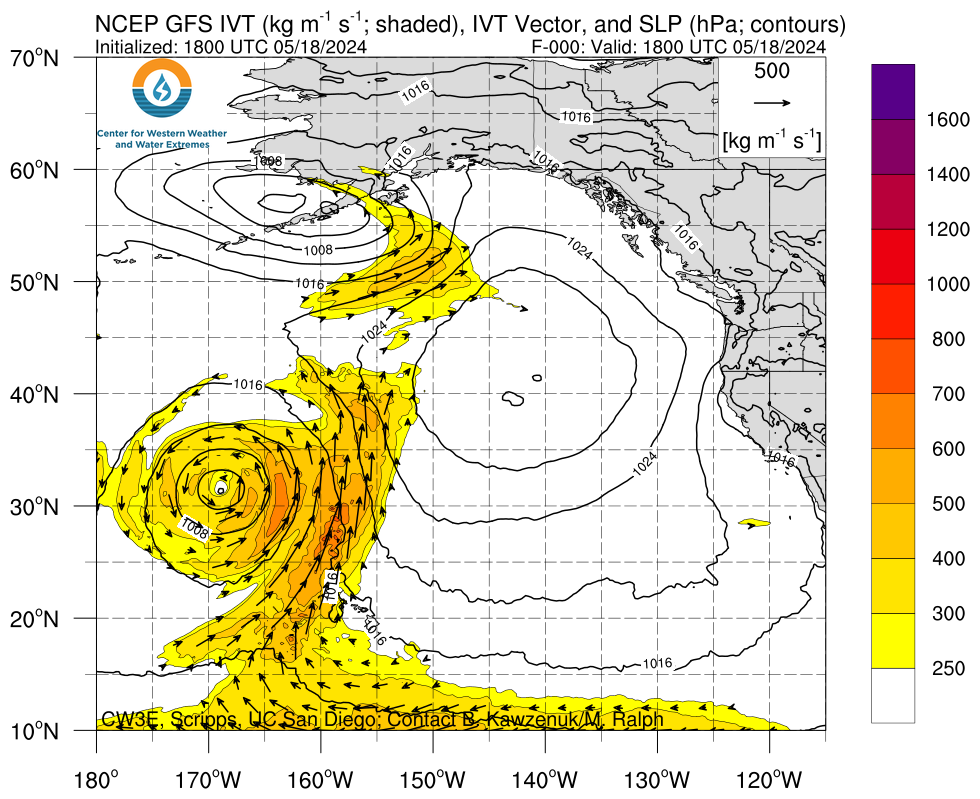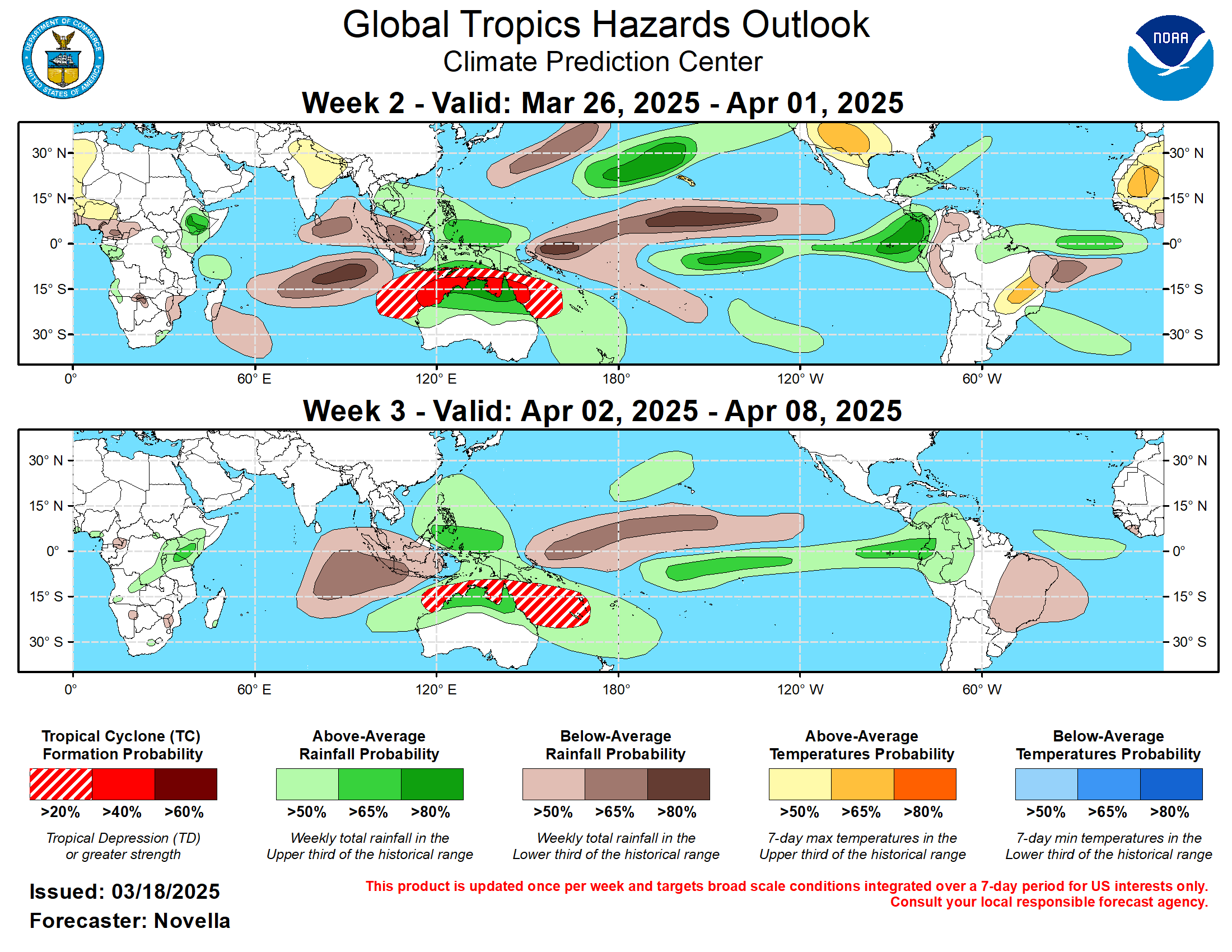This article focuses on what we are paying attention to in the next 48 to 72 hours. The article also includes weather maps for longer-term U.S. outlooks and a six-day World weather outlook which can be very useful for travelers.
First the NWS Short Range Forecast. The afternoon NWS text update can be found here after about 4 p.m. New York time but it is unlikely to have changed very much from the morning update. The images in this article automatically update.
Short Range Forecast Discussion
NWS Weather Prediction Center College Park MD
Tue Aug 13 2024
Valid 12Z Tue Aug 13 2024 – 12Z Thu Aug 15 2024…Heavy rain and flash flooding threat forecast to stretch from the
central Plains to the Midwest over the next few days……Potentially dangerous heat anticipated across the southern Plains,
lower Mississippi Valley, and Gulf Coast……Fire weather concerns and poor air quality continues for portions of
the Pacific Northwest, Northern Rockies, and Great Basin…A mid-August weather pattern continues to take shape this week with
numerous areas of scattered thunderstorms impacting the Nation. A
stationary front currently stretching from the Southeast to the central
High Plains will be the focus for much of this activity, with the boundary
eventually forecast to lift north into the Midwest by Wednesday night due
to a deepening low pressure system in the central Plains. The most likely
weather hazard over the next few days with developing thunderstorms is
expected to be associated with heavy rainfall creating instances of flash
flooding, as well as the potential for isolated areas of damaging wind
gusts. Specifically, three separate areas along the front stand out today
as having the greatest chances for scattered flash floods. Parts of South
Carolina remain sensitive to locally heavy rain as the area continues to
contain saturated ground conditions, leading to a continued threat for
flash flooding as long as the atmosphere supports slow-moving
thunderstorms. For much of eastern Kansas and Missouri, an initial complex
of thunderstorms is forecast to move through the region this morning
containing locally heavy rainfall, while a reforming area of convection
overnight into Wednesday could create additional flooding concerns. This
second round of heavy rain has the potential to produce a narrow corridor
of impressive rainfall totals within a few hours near south-central
Missouri. Additionally, northeast Colorado can expect another round of
storms containing intense rainfall rates this evening as activity forms
along the leeward side of the Rockies and pushes eastward. Residents and
visitors are advised to have multiple ways of receiving warnings, have a
plan should flash flooding occur, and never drive through flooded
roadways. By midweek much of the heavy rain and thunderstorm activity is
anticipated to gradually shift eastward to the Midwest and lower Ohio
Valley, along with the strengthening low pressure system and lifting warm
front. Once again heavy rain will be a concern as ample atmospheric
moisture content creates ripe conditions for scattered vigorous downpours.Dangerous summer heat will be confined to the southern U.S. this week as
highs into the upper 90s and triple digits span from the Southwest to the
Gulf Coast. The most anomalous and potentially dangerous heat is forecast
across the southern Plains and Gulf Coast States through the end of the
week as highs reach up to 10 degrees above the climatological average for
mid-August. Elevated humidity levels will lead to maximum heat indices up
to 110 degrees during the day and low temperatures only dipping into the
upper 70s and low 80s at night. People spending greater time or effort
outdoors, or in a building without effective cooling, are at an increased
risk of heat-related illnesses.A persistent pattern supporting fire weather concerns across much of the
central and northern Great Basin is forecast to continue today with dry
terrain and periods of gusty winds. Red Flag Warnings remain in place from
eastern Oregon to Idaho. Ongoing wildfires also continue to spread smoke
into the atmosphere, leading to poor air quality.
To get your local forecast plus active alerts and warnings click HERE and enter your city, state or zip code.
Learn about wave patterns HERE.
Then, looking at the world and of course, the U.S. shows here also. Today we are looking at precipitation.
Please click on “Read More” below to access the full Daily Report issued today.
| Notices: What would you like to learn about? Please provide that to me via the comment section at the end of the article. |
Now more detail on the 48-Hour Forecast (It is a 48 to 72 Hour Forecast actually)
Daily weather maps. The Day 1 map updates twice a day and the Day 2 and 3 maps update only once a day. These maps update automatically. But if that does not happen, you can get updates by clicking HERE
TODAY (or late in the day the evening/overnight map will appear) (Key to surface fronts shown on maps and you will then also be able to insert a city name or zip code and get a local NWS forecast).
TOMORROW
NEXT DAY
We have a new animation of the forecast which shows how things may play out over the next 60 hours. To update click ANIMATION. Doing so will get you to the dashboard. You can then step through the animation or hit LOOP on the upper right of the display. You will have to hit the back arrow ← at the top left on your computer to get back into this article. It is a little more trouble than before but I think NOAA scrapped the animation routine I was using so we have to keep up with “progress”.
The NWS Climate Prediction Center’s: Watches, Warnings, and Advisories plus other information can be found HERE. That takes you to the NWC Severe Weather Site. From there you can select among many categories of information. Remember to hit the back arrow ← at the top left of your screen to return to this article.
ATMOSPHERIC RIVERS
This tells us what is approaching the West Coast. Click HERE to update If I have not gotten around to doing the update. Here is some useful information about Atmospheric Rivers.
Below is the current five-day cumulative forecast of precipitation (Updates can be found HERE)
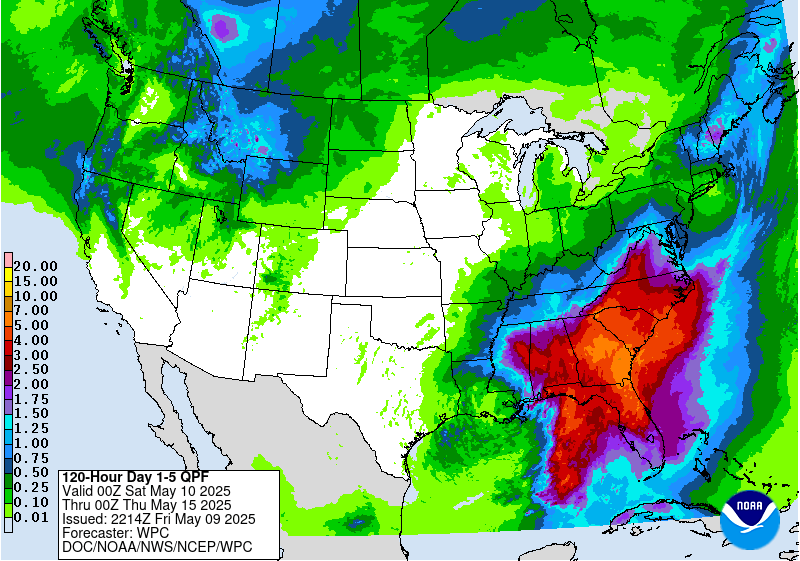
Ski SnowReports will Resume in the Fall.
Now we look at Intermediate-Term “Outlook” maps for three time periods. Days 6 – 10, Days 8 – 14, and Weeks 3 and 4. An outlook differs from a forecast based on how NOAA uses these terms in that an “outlook” presents information as deviation from normal and the likelihood of these deviations.
Below are the links to obtain updates and additional information. They are particularly useful if you happen to be reading this article significantly later than when it was published. I always try to provide readers with the source of the information in my articles. These links may also be useful for those viewing this article on a cell phone or other small screen.
| Days 6 – 10 (shown in Row 1) | Days 8 – 14 (Shown in Row 2) | Weeks 3 and 4 (Shown in Row 3 but updates only on Fridays) |
| https://www.cpc.ncep.noaa. gov/products/predictions/610day/ | https://www.cpc.ncep .noaa.gov/products/predictions/814day/ | https://www.cpc.ncep.noaa.gov/products/predictions/WK34/ |
Showing the actual maps. They should now update automatically. The Week 3 – 4 Outlook only updates on Fridays. So below is what I call the Intermediate-term outlook. On Fridays, it extends out 28 Days. That declines day by day so on Thursday it only looks out 22 days until the next day when the Week 3 – 4 Outlook is updated and this extends the outlook by one additional week.
| 6–
10
|
|
|
| 8–
14 |
|
|
| 3–
4 |
|
|
HAZARDS OUTLOOKS
Click here for the latest complete Day 3 -7 Hazards forecast which updates only on weekdays. Once a week probably Monday or Tuesday I will update the images. I provided the link for readers to get daily updates on weekdays. Use your own judgment to decide if you need to update these images. I update almost all the images Friday Night for the weekend edition of this Weather Report. So normally readers do not need to update these images but if the weather is changing quickly you may want to.
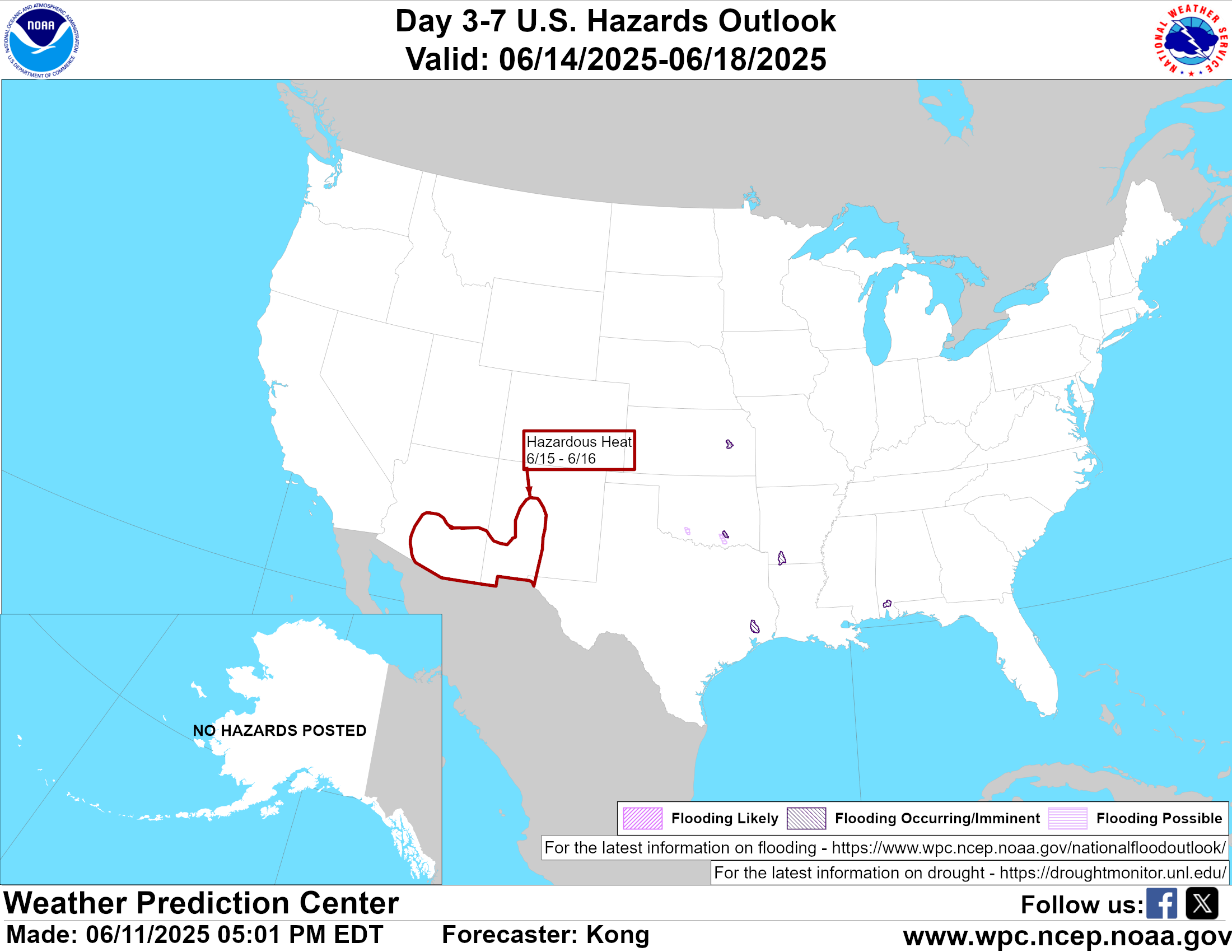
Temperature month to date can be found at https://hprcc.unl.edu/products/maps/acis/MonthTDeptUS.png
Precipitation month to date can be found at https://hprcc.unl.edu/products/maps/acis /MonthPNormUS.png
World Forecast [that website is has been intermittent so be patient]
Below are the Day 1 -3 and 4-6 forecasts for temperature and precipitation. Updates and much additional information can be obtained HERE
World Temperature Anomalies

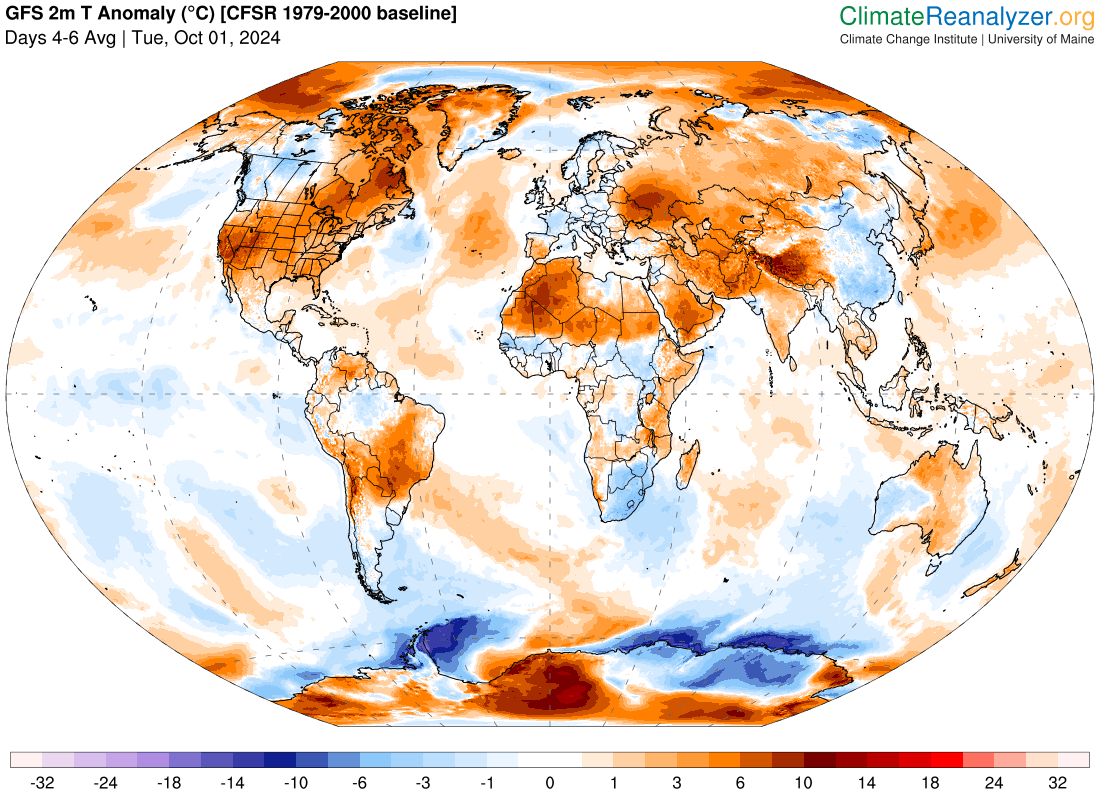
World Accumulated Precipitation
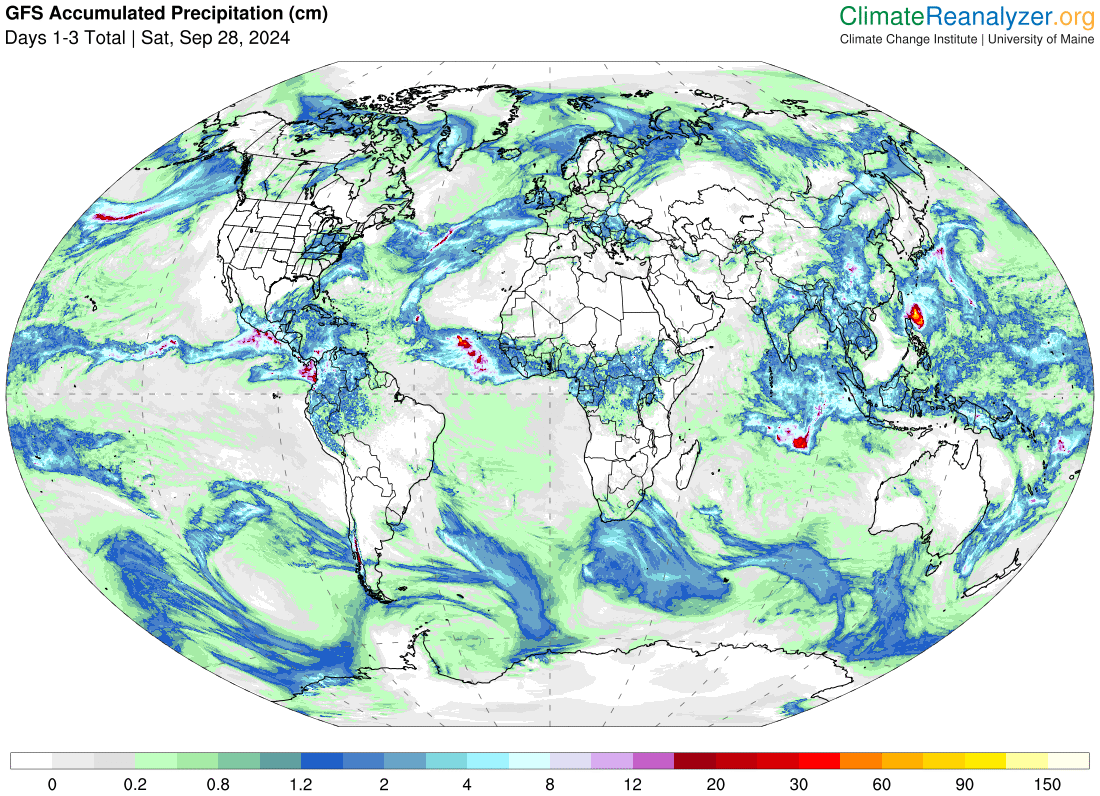

This information is provided by the University of Maine. They draw upon many different sources. There is a lot of information available at the link provided. I have just provided two useful forecasts. There are probably over a hundred different forecasts available from this source.
Worldwide Tropical Forecast (This is a NOAA Product)
This graphic updates on Tuesdays) If it has not been updated, you can get the update by clicking here Readers will only have to do that if they are reading this article much later than the date of it being published.
Information on Tropical Storms can be found HERE. Western Pacific information can be found HERE. Note that unless there is an out-of-season storm the below images will not update until the National Hurricane Center starts their seasonal update of these maps on June 1. I include them simply because there can be an out-of-season event in which case it should show up in these maps.

–
I hope you found this article interesting and useful. –


